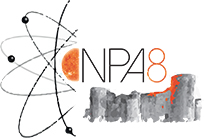Speaker
Rosanna Depalo
(P)
Description
%
% Nuclear Physics in Astrophysics 8 template for abstract
%
% Format: LaTeX2e.
%
% Rename this file to name.tex, where `name' is the family name
% of the first author, and edit it to produce your abstract.
%
\documentstyle[11pt]{article}
%
% PAGE LAYOUT:
%
\textheight=9.9in
\textwidth=6.3in
\voffset -0.85in
\hoffset -0.35in
\topmargin 0.305in
\oddsidemargin +0.35in
\evensidemargin -0.35in
%\renewcommand{\rmdefault}{ptm} % to use Times font
\long\def\TITLE#1{{\Large{\bf#1}}}\long\def\AUTHORS#1{ #1\\[3mm]}
\long\def\AFFILIATION#1#2{$^{#1}\,$ #2\\}
\begin{document}
{\small \it Nuclear Physics in Astrophysics 8, NPA8: 18-23 June 2017, Catania, Italy}
\vspace{12pt}
\thispagestyle{empty}
\begin{center}
%%%
%%% Title goes here.
%%%
\TITLE{A new measurement of the $^{6}$Li(p,$\gamma$)$^{7}$Be cross section at LUNA}\\[3mm]
%%%
%%% Authors and affiliations are next. The presenter should be
%%% underlined as shown below.
%%%
\AUTHORS{R. Depalo$^{1,2}$ for the LUNA collaboration }
%%%
{\small \it
\AFFILIATION{1}{Dipartimento di Fisica e Astronomia, Università degli Studi di Padova, Padova, Italy}
\AFFILIATION{2}{INFN - Sezione di Padova, Padova, Italy}
}
%%%
\vspace{12pt} % Do not modify
% Enter contact e-mail address here.
\centerline{Contact email: {\it rdepalo@pd.infn.it}}
\vspace{18pt} % Do not modify
\end{center}
%%%
%%% Abstract proper starts here.
%%%
The detection of $^{6}$Li in stars is a powerful tool for understanding the Big Bang nucleosynthesis, as well as the early stellar structure and evolution.\\
In stars, lithium is quickly destroyed during the pre-main sequence and main sequence phases, at temperatures of about 2 MK. Theoretical predictions of lithium abundances in the stellar surface are strongly dependent on the input physics and in many cases non-standard processes are required to explain the observed abundances [1].\\
The $^{6}$Li depletion proceeds mainly through the $^{6}$Li(p,$\alpha$)$^{3}$He reaction. This reaction has been studied by many groups, and in order to explain the angular distribution of the emitted alpha particles, an R-matrix fit of the experimental data requires the contribution of both negative and positive parity excited states [2]. \\
Although the existence of positive parity excited states in $^{7}$Be has never been confirmed experimentally,
a recent measurement of the $^{6}$Li(p,$\gamma$)$^{7}$Be cross section revealed a possible resonance-like structure at center of mass energy of 195 keV [3]. The observed S-factor is reproduced by an R-matrix fit assuming the existence of an excited state with E $\approx$ 5800 keV and J$^{\pi}$ = (1/2$^{+}$, 3/2$^{+}$).\\
A new measurement of the $^{6}$Li(p,$\gamma$)$^{7}$Be cross section at proton energies between 50 and 400 keV has been performed at the Laboratory for Underground Nuclear Astrophysics. The poster provides a description of the experimental setup and preliminary results of the data analysis.
\bigskip
{\small
\noindent [1] E. Tognelli et al. A\&A \textbf{548}, A41 (2012)\\
\noindent [2] J. Cruz et al. J. Phys. G Nucl. Part. Phys. \textbf{35}, 014004 (2008)\\
\noindent [3] J. J. He et al. Phys. Lett. B \textbf{725}, 287-291 (2013)\\
%%%
%%% End of abstract.
%%%
\end{document}
Author
Rosanna Depalo
(P)

